Magellan tilts at Venusian windmills
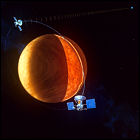 NASA’s Magellan space probe, still orbiting Venus since 1990, enters a phase of slightly riskier experiments, dipping its solar panels into the upper reaches of the Venusian atmosphere and firing its reaction control engines to keep from spinning out of control. This allows for studies of the composition of Venus’ atmosphere, as well as studies of the vehicle’s behavior as it resists atmospheric friction. The results of the “windmill” experiment inform the design of future Mars probes which will need to aerobrake to slow down and enter the Martian atmosphere.
NASA’s Magellan space probe, still orbiting Venus since 1990, enters a phase of slightly riskier experiments, dipping its solar panels into the upper reaches of the Venusian atmosphere and firing its reaction control engines to keep from spinning out of control. This allows for studies of the composition of Venus’ atmosphere, as well as studies of the vehicle’s behavior as it resists atmospheric friction. The results of the “windmill” experiment inform the design of future Mars probes which will need to aerobrake to slow down and enter the Martian atmosphere.
Jupiter eats a comet
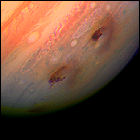 Its collision with the solar system’s largest planet predicted over a year in advance, the fragments of Comet Shoemaker-Levy 9 begin impacting Jupiter’s atmosphere in an astronomical event lasting six days. With Earth-based telescopes watching, as well as cameras and instruments on the Hubble Space Telescope, Galileo and even Voyager 2, huge explosions are witnessed as the cometary chunks slam into Jupiter’s southern hemisphere at over 200,000 miles per hour, leaving dark “scars” larger than the diameter of Earth visible on the planet’s atmosphere and releasing more heat than the surface of the sun. Galileo is still over a year away from arriving at Jupiter.
Its collision with the solar system’s largest planet predicted over a year in advance, the fragments of Comet Shoemaker-Levy 9 begin impacting Jupiter’s atmosphere in an astronomical event lasting six days. With Earth-based telescopes watching, as well as cameras and instruments on the Hubble Space Telescope, Galileo and even Voyager 2, huge explosions are witnessed as the cometary chunks slam into Jupiter’s southern hemisphere at over 200,000 miles per hour, leaving dark “scars” larger than the diameter of Earth visible on the planet’s atmosphere and releasing more heat than the surface of the sun. Galileo is still over a year away from arriving at Jupiter.
Clementine goes off course
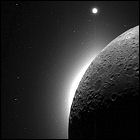 NASA’s Clementine lunar orbiter, its moon mapping mission complete, is directed to fire its engines to put it on a trajectory for asteroid 1620 Geographos, a near-Earth asteroid named for the National Geographic Society (which sponsored a sky survey that led to its discovery). But one of Clementine’s thrusters stays on too long, firing for 11 minutes and revving the vehicle up to an unrecoverable spin of 80 revolutions per minute, exhausting its entire fuel supply in the process. Clementine’s secondary mission to Geographos is abandoned, and its batteries are exhausted a month later.
NASA’s Clementine lunar orbiter, its moon mapping mission complete, is directed to fire its engines to put it on a trajectory for asteroid 1620 Geographos, a near-Earth asteroid named for the National Geographic Society (which sponsored a sky survey that led to its discovery). But one of Clementine’s thrusters stays on too long, firing for 11 minutes and revving the vehicle up to an unrecoverable spin of 80 revolutions per minute, exhausting its entire fuel supply in the process. Clementine’s secondary mission to Geographos is abandoned, and its batteries are exhausted a month later.
GOES-8 goes up
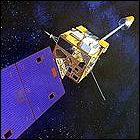 NOAA’s GOES-8 Geostationary Operational Environmental Satellite is launched from Cape Canaveral into a geosynchronous orbit now designated GOES-EAST to monitor weather patterns over the United States; its predecessor, GOES-7, takes up the GOES-WEST position. GOES-8 is a major design evolution in the GOES weather satellite series, incorporating new hardware, some of which proves to be less sturdy than is required for an extensive orbital tour of duty. GOES-8 will remain in the GOES-EAST orbit until it is retired from active weather-watching duty in 2003 and shut down in 2004.
NOAA’s GOES-8 Geostationary Operational Environmental Satellite is launched from Cape Canaveral into a geosynchronous orbit now designated GOES-EAST to monitor weather patterns over the United States; its predecessor, GOES-7, takes up the GOES-WEST position. GOES-8 is a major design evolution in the GOES weather satellite series, incorporating new hardware, some of which proves to be less sturdy than is required for an extensive orbital tour of duty. GOES-8 will remain in the GOES-EAST orbit until it is retired from active weather-watching duty in 2003 and shut down in 2004.
Clementine lifts off
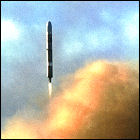 NASA’s Clementine unmanned spacecraft is launched from Vandenberg Air Force Base toward Earth’s moon, the first American spacecraft to aim at that destination since the 1970s. Intended to map the moon with multispectral cameras and obtain a fresh gravity map, Clementine is a huge technological advance over NASA’s last lunar vehicle, featuring a 32-bit image processing system with solid state data storage. Clementine takes a leisurely trajectory to reach its destination, flying by Earth twice before reaching the moon a month after launch.
NASA’s Clementine unmanned spacecraft is launched from Vandenberg Air Force Base toward Earth’s moon, the first American spacecraft to aim at that destination since the 1970s. Intended to map the moon with multispectral cameras and obtain a fresh gravity map, Clementine is a huge technological advance over NASA’s last lunar vehicle, featuring a 32-bit image processing system with solid state data storage. Clementine takes a leisurely trajectory to reach its destination, flying by Earth twice before reaching the moon a month after launch.
Hubble’s corrective lens
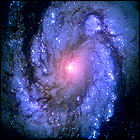 Following the Space Shuttle repair mission to the Hubble Space Telescope, the orbiting telescope’s new Wide Field and Planetary Camera 2 shows incredible improvement in image resolution. By determining the exact deformation of the telescope’s main mirror, the new camera is created almost like corrective glasses: it’s designed to compensate for that deformation at all times. The resulting improvement in image quality is remarkable, enabling Hubble to spot volcanic activity on Io, a moon of Jupiter whose volcanoes have only been visible from space probes making a close flyby. Hubble’s improved vision also arrives just in time to witness an unprecedented event: a cometary collision with Jupiter later in 1994.
Following the Space Shuttle repair mission to the Hubble Space Telescope, the orbiting telescope’s new Wide Field and Planetary Camera 2 shows incredible improvement in image resolution. By determining the exact deformation of the telescope’s main mirror, the new camera is created almost like corrective glasses: it’s designed to compensate for that deformation at all times. The resulting improvement in image quality is remarkable, enabling Hubble to spot volcanic activity on Io, a moon of Jupiter whose volcanoes have only been visible from space probes making a close flyby. Hubble’s improved vision also arrives just in time to witness an unprecedented event: a cometary collision with Jupiter later in 1994.
STS-61: new eyes for Hubble
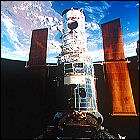 NASA launches Space Shuttle Endeavour on a ten-day mission to retrieve and repair the Hubble Space Telescope, which was launched in 1990 with flawed optics. With the $2,000,000,000 telescope held steady in the cargo bay, Endeavour astronauts conduct repairs during spacewalks totaling over 35 hours of the mission, before releasing Hubble back into orbit with new eyes. Aboard Endeavour for her history-making fifth flight are Commander Richard Covey, Pilot Kenneth Bowersox, Payload Commander Story Musgrave, and mission specialists Kathryn Thornton, Claude Nicollier, Jeffrey Hoffman and Tom Akers.
NASA launches Space Shuttle Endeavour on a ten-day mission to retrieve and repair the Hubble Space Telescope, which was launched in 1990 with flawed optics. With the $2,000,000,000 telescope held steady in the cargo bay, Endeavour astronauts conduct repairs during spacewalks totaling over 35 hours of the mission, before releasing Hubble back into orbit with new eyes. Aboard Endeavour for her history-making fifth flight are Commander Richard Covey, Pilot Kenneth Bowersox, Payload Commander Story Musgrave, and mission specialists Kathryn Thornton, Claude Nicollier, Jeffrey Hoffman and Tom Akers.
Galileo eyes Ida
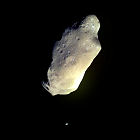 Bound for Jupiter, the NASA/JPL unmanned space probe Galileo swings past the asteroid Ida, discovering – for the first time – an asteroid with its own satellite, a tiny body orbiting Ida. The satellite is later named Dactyl. This is only the second asteroid to be visited by a spacecraft from Earth, and Ida also marks Galileo’s last visit to a body in the solar system before a two-year cruise toward Jupiter.
Bound for Jupiter, the NASA/JPL unmanned space probe Galileo swings past the asteroid Ida, discovering – for the first time – an asteroid with its own satellite, a tiny body orbiting Ida. The satellite is later named Dactyl. This is only the second asteroid to be visited by a spacecraft from Earth, and Ida also marks Galileo’s last visit to a body in the solar system before a two-year cruise toward Jupiter.
Magellan tests aerobraking at Venus
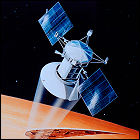 To increase the accuracy of its gravity map of the planet Venus, NASA’s unmanned space probe Magellan conducts the first experimental aerobraking maneuvers to alter the shape its orbit to a near-circular shape. By dipping Magellan into the upper layers of the Venusian atmosphere, the spacecraft is slowed and its orbit is changed, but it is kept far enough from the denser lower layers of the atmosphere to avoid re-entry. Aerobraking will become more commonly used by future space probes at the planet Mars.
To increase the accuracy of its gravity map of the planet Venus, NASA’s unmanned space probe Magellan conducts the first experimental aerobraking maneuvers to alter the shape its orbit to a near-circular shape. By dipping Magellan into the upper layers of the Venusian atmosphere, the spacecraft is slowed and its orbit is changed, but it is kept far enough from the denser lower layers of the atmosphere to avoid re-entry. Aerobraking will become more commonly used by future space probes at the planet Mars.
Galileo’s last visit home
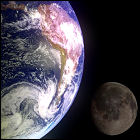 Catching the last gravity assist on its four-year “VEEGA” tour of the inner solar system, NASA/JPL’s Galileo spacecraft swings past Earth one last time, conducting further tests of its imaging system and other instruments by examining Earth and its moon. Galileo now sets its sights on the outer solar system, where it will take up an orbit around giant planet Jupiter in 1995, studing the planet and its atmosphere, its moons, and its unfriendly-to-spacecraft radiation environment. Efforts to release the vehicle’s stuck high-gain antenna continue, though NASA admits that, within a few months, they will have to begin planning for a mission that can only make use of the low-bit-rate medium-gain antenna.
Catching the last gravity assist on its four-year “VEEGA” tour of the inner solar system, NASA/JPL’s Galileo spacecraft swings past Earth one last time, conducting further tests of its imaging system and other instruments by examining Earth and its moon. Galileo now sets its sights on the outer solar system, where it will take up an orbit around giant planet Jupiter in 1995, studing the planet and its atmosphere, its moons, and its unfriendly-to-spacecraft radiation environment. Efforts to release the vehicle’s stuck high-gain antenna continue, though NASA admits that, within a few months, they will have to begin planning for a mission that can only make use of the low-bit-rate medium-gain antenna.
Farewell to Pioneer Venus
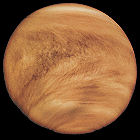 The Pioneer Venus Orbiter, launched into orbit around Venus in 1978 and now the only surviving component of the Pioneer Venus mission, enters the cloudy planet’s dense, toxic atmosphere and disintegrates, its fuel supply too exhausted to keep it in orbit any longer. Originally intended to orbit Venus for only a year, Pioneer Venus has survived, fully functional, for nearly 14 years in Venusian orbit, continuing to study the planet and taking readings not only Venus but such objects as Halley’s Comet.
The Pioneer Venus Orbiter, launched into orbit around Venus in 1978 and now the only surviving component of the Pioneer Venus mission, enters the cloudy planet’s dense, toxic atmosphere and disintegrates, its fuel supply too exhausted to keep it in orbit any longer. Originally intended to orbit Venus for only a year, Pioneer Venus has survived, fully functional, for nearly 14 years in Venusian orbit, continuing to study the planet and taking readings not only Venus but such objects as Halley’s Comet.
Magellan goes fourth at Venus
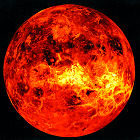 NASA’s unmanned Magellan space probe, having completed three extensive campaigns of mapping the surface of Venus from orbit with cloud-penetrating radar, begins a fourth mission phase, this time sending constant engineering telemetry to Earth, where measurements of Doppler shift in the signal received allows Earthbound scientists to map the gravitational field of Venus. Magellan’s map-making days are over, having achieved a 98% complete map of the cloud-shrouded planet that it has been orbiting since 1990.
NASA’s unmanned Magellan space probe, having completed three extensive campaigns of mapping the surface of Venus from orbit with cloud-penetrating radar, begins a fourth mission phase, this time sending constant engineering telemetry to Earth, where measurements of Doppler shift in the signal received allows Earthbound scientists to map the gravitational field of Venus. Magellan’s map-making days are over, having achieved a 98% complete map of the cloud-shrouded planet that it has been orbiting since 1990.
Pluto Fast Flyby
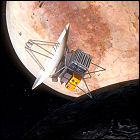 NASA and JPL announce a plan is in the works to launch small twin spacecraft toward the planet Pluto. The Pluto Fast Flyby mission would launch two vehicles in 1997 or 1998, much smaller than the Voyager spacecraft that have explored the larger outer planets, with the two vehicles possibly arriving at Pluto as early as 2005 or 2007. Pluto Fast Flyby has the support of NASA’s new administrator and the White House, both of whom are insisting that NASA embrace a “faster, better, cheaper” space exploration philosophy. To save weight and energy, the initial mission proposal calls for no instruments other than cameras. This meets with protests from scientists (and proponents of the earlier Pluto 350 mission proposal). In the rapidly changing political climate at NASA, the Pluto Fast Flyby proposal lasts less than a year.
NASA and JPL announce a plan is in the works to launch small twin spacecraft toward the planet Pluto. The Pluto Fast Flyby mission would launch two vehicles in 1997 or 1998, much smaller than the Voyager spacecraft that have explored the larger outer planets, with the two vehicles possibly arriving at Pluto as early as 2005 or 2007. Pluto Fast Flyby has the support of NASA’s new administrator and the White House, both of whom are insisting that NASA embrace a “faster, better, cheaper” space exploration philosophy. To save weight and energy, the initial mission proposal calls for no instruments other than cameras. This meets with protests from scientists (and proponents of the earlier Pluto 350 mission proposal). In the rapidly changing political climate at NASA, the Pluto Fast Flyby proposal lasts less than a year.
The future of Mars exploration
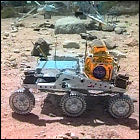 A tech demonstration at the Jet Propulsion Laboratory leads to a rethink of the upcoming Mars Environmental Survey mission (MESUR). A self-contained “rover” named Rocky IV convinces mission planners to include a similar rover on an upcoming Mars mission; although the rest of MESUR is eventually scrapped due to budget cuts, the one portion of it to be salvaged is the Mars Pathfinder lander, which will deliver the rover (later to be named Sojourner in a nationwide contest) to the Martian surface sometime in the late ’90s.
A tech demonstration at the Jet Propulsion Laboratory leads to a rethink of the upcoming Mars Environmental Survey mission (MESUR). A self-contained “rover” named Rocky IV convinces mission planners to include a similar rover on an upcoming Mars mission; although the rest of MESUR is eventually scrapped due to budget cuts, the one portion of it to be salvaged is the Mars Pathfinder lander, which will deliver the rover (later to be named Sojourner in a nationwide contest) to the Martian surface sometime in the late ’90s.
Magellan: mapping Venus in stereo
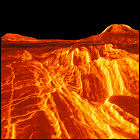 The third phase of data gathering begins for NASA’s Magellan unmanned space probe, launched via space shuttle in 1989 and currently orbiting the heavily-clouded planet Venus. Using radar to peer through the planet’s dense clouds, Magellan has now mapped 96% of the planet’s surface, and will now spend much of the remainder of 1992 filling in details in regions it has missed, as well as re-scanning some regions of Venus stereoscopically, allowing for three-dimensional terrain reconstruction.
The third phase of data gathering begins for NASA’s Magellan unmanned space probe, launched via space shuttle in 1989 and currently orbiting the heavily-clouded planet Venus. Using radar to peer through the planet’s dense clouds, Magellan has now mapped 96% of the planet’s surface, and will now spend much of the remainder of 1992 filling in details in regions it has missed, as well as re-scanning some regions of Venus stereoscopically, allowing for three-dimensional terrain reconstruction.
Galileo gawks at Gaspra
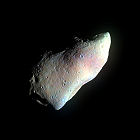 NASA/JPL’s Galileo space probe, looping repeatedly through the inner solar system to gain a speed boost from a series of gravity assists from Earth and Venus, passes the asteroid 951 Gaspra, the first human-made spacecraft to visit such a body. Where humanity’s previous knowledge of asteroids was limited at best, Galileo’s findings are startling, with photos showing a small rocky body pummeled by ancient impacts, almost to the point of shattering it. Also discovered is a magnetic field generated by the core of the asteroid itself, something planetary scientists did not expect to find at all. Galileo will loop back toward Earth, picking up a critical speed boost to Jupiter from one last flyby of its home planet.
NASA/JPL’s Galileo space probe, looping repeatedly through the inner solar system to gain a speed boost from a series of gravity assists from Earth and Venus, passes the asteroid 951 Gaspra, the first human-made spacecraft to visit such a body. Where humanity’s previous knowledge of asteroids was limited at best, Galileo’s findings are startling, with photos showing a small rocky body pummeled by ancient impacts, almost to the point of shattering it. Also discovered is a magnetic field generated by the core of the asteroid itself, something planetary scientists did not expect to find at all. Galileo will loop back toward Earth, picking up a critical speed boost to Jupiter from one last flyby of its home planet.
More from Magellan the mapmaker
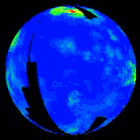 NASA’s Magellan space probe, which has been mapping the planet Venus from orbit since September 1990, completes the first phase of its map-making mission, completing radar imaging of more than 80% of the planet’s surface. NASA authorizes an extended mission, lasting into 1992, which will yield a more complete map of the Venusian surface, including its polar regions.
NASA’s Magellan space probe, which has been mapping the planet Venus from orbit since September 1990, completes the first phase of its map-making mission, completing radar imaging of more than 80% of the planet’s surface. NASA authorizes an extended mission, lasting into 1992, which will yield a more complete map of the Venusian surface, including its polar regions.
Galileo’s antenna problem
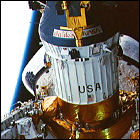 Launched in 1989 via Space Shuttle, the unmanned Galileo probe reveals a significant technical problem during its first flyby of Earth: the umbrella-like high-gain antenna, allowing it to send its observations of Jupiter and its moons back to Earth at high speed, is stuck in a partly-open, partly-closed configuration that prevents its use. Ground engineers at JPL have to devise data compression schemes, and a tight record/playback schedule, that will allow Galileo to take all of its planned observations and send them back to Earth at a lower bit rate than planned. It is theorized that the long delays in Galileo’s launch – the probe was ready for launch in 1982 but had to wait through delays in the early shuttle program and was then kept in storage in the aftermath of the Challenger disaster – allowed the antenna’s lubricant to dry up. Galileo won’t reach its target planet, Jupiter, until 1995.
Launched in 1989 via Space Shuttle, the unmanned Galileo probe reveals a significant technical problem during its first flyby of Earth: the umbrella-like high-gain antenna, allowing it to send its observations of Jupiter and its moons back to Earth at high speed, is stuck in a partly-open, partly-closed configuration that prevents its use. Ground engineers at JPL have to devise data compression schemes, and a tight record/playback schedule, that will allow Galileo to take all of its planned observations and send them back to Earth at a lower bit rate than planned. It is theorized that the long delays in Galileo’s launch – the probe was ready for launch in 1982 but had to wait through delays in the early shuttle program and was then kept in storage in the aftermath of the Challenger disaster – allowed the antenna’s lubricant to dry up. Galileo won’t reach its target planet, Jupiter, until 1995.
Galileo visits a small blue planet
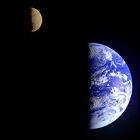 NASA/JPL’s Galileo space probe reaches the second destination on the lengthy “VEEGA” (Venus/Earth/Earth Gravity Assist) flight path that will eventually take it to Jupiter. This leg of Galileo’s journey brings it back to its home planet, Earth, where crystal-clear images of the planet are obtained from the perspective of a passing spacecraft. Galileo will loop past Earth once more at a later date en route to Jupiter.
NASA/JPL’s Galileo space probe reaches the second destination on the lengthy “VEEGA” (Venus/Earth/Earth Gravity Assist) flight path that will eventually take it to Jupiter. This leg of Galileo’s journey brings it back to its home planet, Earth, where crystal-clear images of the planet are obtained from the perspective of a passing spacecraft. Galileo will loop past Earth once more at a later date en route to Jupiter.
Magellan the mapmaker
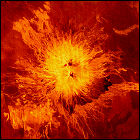 NASA’s Magellan space probe, orbiting the planet Venus, has completed a checkout phase and begins its primary mapping mission, intended to gather data of the Venusian surface as high resolution as one kilometer per pixel. Rather than using visible light – which would yield only images of Venus’ dense clouds – Magellan uses radar to map the planet’s blistering hot surface. Launched in May 1989 via space shuttle, Magellan will continue mapping the surface of Venus through May 1991.
NASA’s Magellan space probe, orbiting the planet Venus, has completed a checkout phase and begins its primary mapping mission, intended to gather data of the Venusian surface as high resolution as one kilometer per pixel. Rather than using visible light – which would yield only images of Venus’ dense clouds – Magellan uses radar to map the planet’s blistering hot surface. Launched in May 1989 via space shuttle, Magellan will continue mapping the surface of Venus through May 1991.
Magellan arrives at Venus
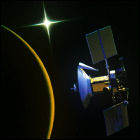 Launched via space shuttle in May 1989, the long-delayed Magellan space probe reaches the planet Venus after an unusually long voyage (15 months) and begins an orbital insertion maneuver. Where most missions to Venus have reached the planet in only a few months, Magellan has had to make do without the more powerful Centaur liquid-fueled booster stage, resulting in a journey of a year and three months. (The Centaur upper stage had been cancelled after the Challenger disaster because it was felt that carrying an additional liquid-fueled rocket in a shuttle cargo bay was too risky.) Magellan is placed into an elliptical orbit, completely circling Venus every three hours, where it will conduct high-resolution radar mapping of the surface at the closest point in its orbit, and transmitting the resulting data to Earth while furthest from Venus. The first phase of the mapping mission will last through 1991.
Launched via space shuttle in May 1989, the long-delayed Magellan space probe reaches the planet Venus after an unusually long voyage (15 months) and begins an orbital insertion maneuver. Where most missions to Venus have reached the planet in only a few months, Magellan has had to make do without the more powerful Centaur liquid-fueled booster stage, resulting in a journey of a year and three months. (The Centaur upper stage had been cancelled after the Challenger disaster because it was felt that carrying an additional liquid-fueled rocket in a shuttle cargo bay was too risky.) Magellan is placed into an elliptical orbit, completely circling Venus every three hours, where it will conduct high-resolution radar mapping of the surface at the closest point in its orbit, and transmitting the resulting data to Earth while furthest from Venus. The first phase of the mapping mission will last through 1991.
Pluto 350
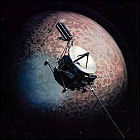 Encouraged by the public interest in Voyager 2’s recent visit to Neptune, scientist Robert Farquhar and graduate student Alan Stern pitch a concept for a compact mission, using hardware derived from the Voyager program, to the planet Pluto. Named Pluto 350, for the 350-kilogram upper weight limit decided on as a feasible and affordable launch weight, their proposed mission would launch in November 2001, have a close encounter with asteroid 1442 Corvina in 2002, then a return to Earth to catch a gravity assist in 2005, with a further gravity assist at Jupiter boosting Pluto 350 to its final target in 2015. In addition to pitching this plan to NASA, Farquhar and Stern appeal to the public by publishing a detailed six-page mission plan in the pages of the Planetary Society’s newsletter. However, a tendency toward larger spacecraft – such as the Mariner Mark II architecture envisioned for the upcoming Cassini and CRAF missions – means that Pluto 350 is not given serious consideration by NASA.
Encouraged by the public interest in Voyager 2’s recent visit to Neptune, scientist Robert Farquhar and graduate student Alan Stern pitch a concept for a compact mission, using hardware derived from the Voyager program, to the planet Pluto. Named Pluto 350, for the 350-kilogram upper weight limit decided on as a feasible and affordable launch weight, their proposed mission would launch in November 2001, have a close encounter with asteroid 1442 Corvina in 2002, then a return to Earth to catch a gravity assist in 2005, with a further gravity assist at Jupiter boosting Pluto 350 to its final target in 2015. In addition to pitching this plan to NASA, Farquhar and Stern appeal to the public by publishing a detailed six-page mission plan in the pages of the Planetary Society’s newsletter. However, a tendency toward larger spacecraft – such as the Mariner Mark II architecture envisioned for the upcoming Cassini and CRAF missions – means that Pluto 350 is not given serious consideration by NASA.
Hubble’s vision problem
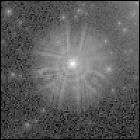 The earliest test images from the Hubble Space Telescope alert ground-based astronomers to a serious problem: the telescope’s huge mirror has been ground to an incorrect shape, leaving the $2,000,000,000 telescope with a vision problem resulting in blurry pictures. Though they’re still an improvement over ground-based telescopes, the telescope’s main selling point – high-resolution images of distant objects – is moot. With the public considering the expensive satellite a failure (oblivious to the fact that it can be serviced via Space Shuttle), NASA begins an extensive investigation into the problem, arriving at a possible repair that can’t be applied until the first shuttle servicing mission to Hubble in 1993. In the meantime, attempts to correct the problem with Earthbound computer image processing yield some usable images.
The earliest test images from the Hubble Space Telescope alert ground-based astronomers to a serious problem: the telescope’s huge mirror has been ground to an incorrect shape, leaving the $2,000,000,000 telescope with a vision problem resulting in blurry pictures. Though they’re still an improvement over ground-based telescopes, the telescope’s main selling point – high-resolution images of distant objects – is moot. With the public considering the expensive satellite a failure (oblivious to the fact that it can be serviced via Space Shuttle), NASA begins an extensive investigation into the problem, arriving at a possible repair that can’t be applied until the first shuttle servicing mission to Hubble in 1993. In the meantime, attempts to correct the problem with Earthbound computer image processing yield some usable images.
STS-31: launching Hubble
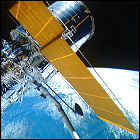 In the planning stages since the 1970s, and delayed by the post-Challenger-disaster downtime for the shuttle program, the Hubble Space Telescope is finally lifted into orbit aboard Space Shuttle Discovery. Hubble is just one of the scientific payloads for the five-day flight, with other experiments being conducted in the crew cabin and the cargo bay. Discovery’s crew for this flight is Commander Loren Shriver, Pilot Charles Bolden, and mission specialists Steven Hawley, Bruce McCandless and Kathryn Sullivan.
In the planning stages since the 1970s, and delayed by the post-Challenger-disaster downtime for the shuttle program, the Hubble Space Telescope is finally lifted into orbit aboard Space Shuttle Discovery. Hubble is just one of the scientific payloads for the five-day flight, with other experiments being conducted in the crew cabin and the cargo bay. Discovery’s crew for this flight is Commander Loren Shriver, Pilot Charles Bolden, and mission specialists Steven Hawley, Bruce McCandless and Kathryn Sullivan.
Voyager 1 looks homeward
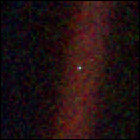 At the request of astronomer Carl Sagan, NASA and JPL reawaken Voyager 1‘s camera for a last look back at Earth and its solar system, from a mind-boggling distance of 4,000,000,000 miles. The “last look” is actually composed of 60 separate photos, capturing most of the planets (with the exception of Mars and Mercury), including Earth – which takes up less than a single pixel in the image. Sagan points to the image as evidence of the fragility and uniqueness of Earth, and names his next book after the photo, “Pale Blue Dot”, also centered on that theme.
At the request of astronomer Carl Sagan, NASA and JPL reawaken Voyager 1‘s camera for a last look back at Earth and its solar system, from a mind-boggling distance of 4,000,000,000 miles. The “last look” is actually composed of 60 separate photos, capturing most of the planets (with the exception of Mars and Mercury), including Earth – which takes up less than a single pixel in the image. Sagan points to the image as evidence of the fragility and uniqueness of Earth, and names his next book after the photo, “Pale Blue Dot”, also centered on that theme.
Galileo at Venus
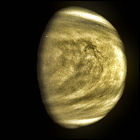 NASA/JPL’s Galileo space probe – eventually bound for Jupiter – reaches the first destination on its looping “VEEGA” (Venus/Earth/Earth Gravity Assist) trajectory, the planet Venus. This flyby of Venus allows for testing of Galileo’s cameras and other science instruments, offering the first near-infrared views of the planet’s dense clouds, and the discovery that there is almost no water vapor in Venus’ thick carbon-dioxide atmosphere. The next “stop” for Galileo is Earth, mere months later.
NASA/JPL’s Galileo space probe – eventually bound for Jupiter – reaches the first destination on its looping “VEEGA” (Venus/Earth/Earth Gravity Assist) trajectory, the planet Venus. This flyby of Venus allows for testing of Galileo’s cameras and other science instruments, offering the first near-infrared views of the planet’s dense clouds, and the discovery that there is almost no water vapor in Venus’ thick carbon-dioxide atmosphere. The next “stop” for Galileo is Earth, mere months later.
STS-34
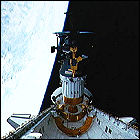 Space Shuttle Atlantis lifts off on a mission lasting nearly five days, whose primary goal is to lift the interplanetary probe Galileo into orbit. Originally intended for launch in late 1982, Galileo is bound for Jupiter by way of a long, looping trajectory that sends it to Venus and back to Earth multiple times, picking up speed via gravitational assist with each visit. Galileo won’t actually reach Jupiter itself until December 1995. Aboard Atlantis for this flight are Commander Donald Williams, Pilot Michael McCulley, and mission specialists Franklin Chang-Diaz, Shannon Lucid, and Ellen S. Baker.
Space Shuttle Atlantis lifts off on a mission lasting nearly five days, whose primary goal is to lift the interplanetary probe Galileo into orbit. Originally intended for launch in late 1982, Galileo is bound for Jupiter by way of a long, looping trajectory that sends it to Venus and back to Earth multiple times, picking up speed via gravitational assist with each visit. Galileo won’t actually reach Jupiter itself until December 1995. Aboard Atlantis for this flight are Commander Donald Williams, Pilot Michael McCulley, and mission specialists Franklin Chang-Diaz, Shannon Lucid, and Ellen S. Baker.
The People vs. Galileo?
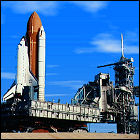 A lawsuit, filed by environmental activists worried about the release of plutonium from the Galileo Jupiter probe’s radioisotope thermoelectric generators in the event of a Challenger-like disaster during launch, is dismissed by a federal judge; the President of the United States has also given permission for the launch to proceed (a requirement anytime a nuclear-fueled spacecraft is in the works). The suit, filed earlier in the year, sought an injunction to prevent Galileo from being launched. Times have changed since the last RTG-powered flight (the Voyager missions of the 1970s), and activists are concerned about a Chernobyl-style radioactive disaster, although the plutonium 238 at the heart of Galileo’s power supply (and that of other interplanetary probes that have used it) is non-weapons-grade and non-fissible. Galileo is slated to be launched in a week aboard the space shuttle Atlantis.
A lawsuit, filed by environmental activists worried about the release of plutonium from the Galileo Jupiter probe’s radioisotope thermoelectric generators in the event of a Challenger-like disaster during launch, is dismissed by a federal judge; the President of the United States has also given permission for the launch to proceed (a requirement anytime a nuclear-fueled spacecraft is in the works). The suit, filed earlier in the year, sought an injunction to prevent Galileo from being launched. Times have changed since the last RTG-powered flight (the Voyager missions of the 1970s), and activists are concerned about a Chernobyl-style radioactive disaster, although the plutonium 238 at the heart of Galileo’s power supply (and that of other interplanetary probes that have used it) is non-weapons-grade and non-fissible. Galileo is slated to be launched in a week aboard the space shuttle Atlantis.
Hubble Space Telescope…for the Apple II
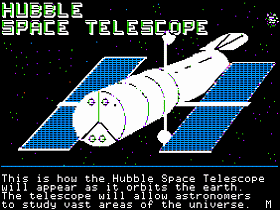 NASA releases an interactive electronic educational guide to the upcoming Hubble Space Telescope for the Apple II computer. Featuring diagrams of the orbiting telescope’s construction, methods of communication with Earth, and how it gathers its images. The software is released ahead of HST’s launch aboard an upcoming shuttle flight.
NASA releases an interactive electronic educational guide to the upcoming Hubble Space Telescope for the Apple II computer. Featuring diagrams of the orbiting telescope’s construction, methods of communication with Earth, and how it gathers its images. The software is released ahead of HST’s launch aboard an upcoming shuttle flight.
Voyager 2 outbound
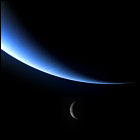 NASA’s unmanned Voyager 2 space probe leaves the vicinity of the planet Neptune, the outermost planet to have been explored by a man-made spacecraft. (At this point in time, Pluto is still considered a planet – the only one to which NASA hasn’t sent a space probe – though by the time a vehicle is dispatched to Pluto in the 21st century, Pluto has been demoted to “minor planet” status.) Though not expected to function beyond 2025 due to the slow decay of its nuclear power source, Voyager 2 may survive long enough to pass within 25,000,000,000,000 miles of Sirius in a quarter of a million years.
NASA’s unmanned Voyager 2 space probe leaves the vicinity of the planet Neptune, the outermost planet to have been explored by a man-made spacecraft. (At this point in time, Pluto is still considered a planet – the only one to which NASA hasn’t sent a space probe – though by the time a vehicle is dispatched to Pluto in the 21st century, Pluto has been demoted to “minor planet” status.) Though not expected to function beyond 2025 due to the slow decay of its nuclear power source, Voyager 2 may survive long enough to pass within 25,000,000,000,000 miles of Sirius in a quarter of a million years.